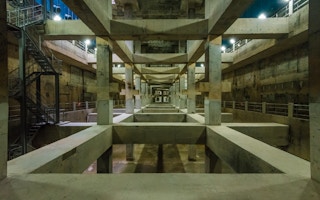Low-lying Singapore could spend S$100 billion (US$72 billion) or more over the next 50 to 100 years to adapt to climate change and rising sea levels, said its prime minister Lee Hsien Loong in one of his biggest political speeches of the year on Sunday.
To continue reading, subscribe to Eco‑Business.
There's something for everyone. We offer a range of subscription plans.
- Access our stories and receive our Insights Weekly newsletter with the free EB Member plan.
- Unlock unlimited access to our content and archive with EB Circle.
- Publish your content with EB Premium.
Climate change defences are a matter of “life and death” for Singapore, which is especially vulnerable to rising sea levels, said Lee at the National Day Rally. This is due to much of the country lying no more than four metres above the mean sea level and its location in Southeast Asia, which scientists have said will bear the brunt of melting ice sheets in the Arctic and Antarctic. Sea levels are projected to rise by up to one metre by the end of this century.
“We should treat climate change defences like we treat the Singapore Armed Forces—with utmost seriousness. Work steadily at it, maintain a stable budget year after year…do it over many years and several generations,” said Lee.
“Both the Singapore Armed Forces and climate change defences are existential for Singapore. These are life and death matters. Everything else must bend at the knee to safeguard the existence of our island nation,” he said.
“We must make this effort. Otherwise one day, our children and grandchildren will be ashamed of what our generation did not do,” he added.
The authorities have determined that Singapore’s eastern coastline and the city centre are particularly vulnerable, and will be given priority.
“
Both the Singapore Armed Forces and climate change defences are existential for Singapore. These are life and death matters. Everything else must bend at the knee to safeguard the existence of our island nation.
Lee Hsien Loong, Prime Minister, Singapore
And Singapore will draw inspiration from the Dutch.
Polders—reclaimed land enclosed by dykes which require pumps to remove excess water—could be established along the east coast, said Lee. These polders can be used for housing and other purposes, and will be protected by a seawall. Singapore is already undertaking a polder project on one of its offshore islands used for military training.
Another option is to reclaim a series of offshore islands from Marina East in the city centre, all the way to the eastern tip of Changi where the country’s airport is sited. “We join up the islands, connect them up with barrages and create a freshwater reservoir,” said Lee, who added that this would boost Singapore’s water security.
The problem of rising sea levels can be tackled with good engineering solutions, but they will cost money, he said. Singapore will study all options and decide on the best way when the time comes.
Besides measures that will protect low-lying areas, localised measures include requiring new developments to be at least four metres above mean sea level, and critical infrastructure like Changi Airport Terminal 5 and the Tuas Port to be built at least an additional metre higher.
Emissions target ambitious enough?
In his speech—possibly his most detailed remarks yet on Singapore’s climate vulnerabilities and adaptation plans—Lee also spoke about the need to reduce carbon emissions.
Singapore is one of the signatories of the Paris Agreement and has pledged to reduce emissions intensity by 36 per cent from 2005 levels by 2030, with the aim of peaking around that time—a commitment Lee reiterated on Sunday.
Given that scientists have said global emissions need to peak as soon as possible and be sharply reduced by 2050 to keep warming to below 2°C above pre-industrial levels, many countries’ Paris Agreement pledges have been deemed inadequate.
Some have also questioned if Singapore’s targets are ambitious enough for a country with among the world’s highest emissions per capita rates.
Organisers of the SG Climate Rally next month, for instance, want Singapore’s absolute greenhouse gas emissions to peak by next year, halve by 2030 and reach net zero by 2050.
Singapore generated 50.9 million tonnes of heat-trapping greenhouse gases in 2014—the latest year for which figures are available— an increase of 4.8 per cent from 2012. Most of it was from the burning of fossil fuels to generate energy for industries, buildings and transportation.
Singapore’s efforts are similar to that of developing nations and it is claiming exemption for more drastic measures under a special United Nations Framework Convention on Climate Change article, which recognises country-specific limitations, Dr Matthias Roth of the National University of Singapore’s geography department has previously noted.
Lee said on Sunday that Singapore can contribute to solutions and must do its fair share to address “one of the gravest challenges facing humankind”.
While the country introduced a carbon tax this year, it also generates a “huge amount of waste” from excessive packaging, unused food and discarded electronics, he said.
In the wake of a deadly heatwave across Western Europe earlier this year, scientists from the Centre for Climate Research Singapore said that as early as 2045, Singapore residents could face some days of the year where temperatures hit 40°C, if the world continues to generate greenhouse gas emissions at business-as-usual rates.

















